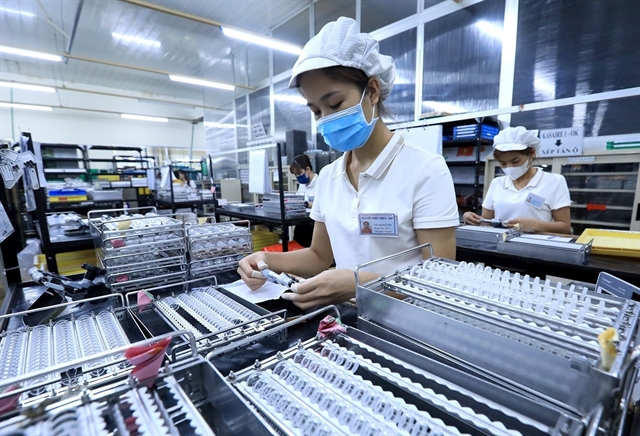 Economy
Economy

 |
| Bicycle production at Thống Nhất JSC. The industry sector grew by 9.11 per cent in the third quarter of the year and remains a strong pillar of the economy. — VNA/VNS Photo Tuấn Anh |
HÀ NỘI — Việt Nam’s gross domestic products (GDP) in the third quarter of the year (Q3) reached an annual increase of 7.4 per cent despite damage caused by Typhoon Yagi, the General Statistics Office (GSO) announced on Sunday.
This was lower than the GDP growth rate of Q3 2022 (13.67 per cent), but higher than that of Q3 2021 (-6.17 per cent).
The industry and construction, and service sectors remain the core pillars of the economy, with a growth rate of 9.11 and 7.51 per cent, respectively, compared to Q3 2023.
The percentage of Q3 growth contributed by these two sectors was 48.88 per cent and 47.04 per cent, respectively, and the agriculture, forestry and fishery sector 4.08 per cent.
Due to agricultural losses caused by Typhoon Yagi, despite growing by 2.58 per cent compared to Q3 2023, this was the lowest growth rate of the agriculture, forestry and fishery sector in three years, since Q3 2021.
In the first nine months of 2024, GDP increased by 6.82 per cent over the same period of 2023.
The agriculture, forestry and fishery sector grew by 3.20 per cent, which was only higher than the growth rate of the same period in 2020, also due to Typhoon Yagi.
Regarding inflation, the average consumer price index (CPI) in Q3 this year increased by 3.48 per cent compared to last year.
In the last nine months, CPI increased by 3.88 per cent compared to last year, and inflation increased by 2.69 per cent.
There was a positive balance between exports and imports of goods in the first nine months of this year, which resulted in a goods trade surplus of $20.8 billion.
However, there was a negative balance between exports and imports of services in the same period, which resulted in a services trade deficit of $9.2 billion.
 |
| Director general of the General Statistics Office Nguyễn Thị Hương speaks at the conference in Hà Nội on Sunday. — VNA/VNS Photo Phương Anh |
Speaking at the conference, GSO director general Nguyễn Thị Hương said the immense efforts from the people, the State and the Government have helped the economy retain a relatively stable growth despite substantial losses to agricultural production in the north due to Typhoon Yagi.
“There were positive signs in the economy in the third quarter and nine months of 2024, with all sectors and fields striving for good results, which created the momentum for growth in the remaining months of the year,” she said.
The Prime Minister has set the GDP growth rate for this year at 7 per cent at the Government meeting in June, Hương added.
“We have had growth of 6.82 per cent in the last nine months, so we keep that up, the target is achievable,” she said.
Nguyễn Thu Oanh, head of GSO’s price statistics department, said it is likely that inflation will remain under control until the end of the year, meeting the National Assembly’s target for an inflation rate of 4-4.5 per cent.
“From our observation, the CPI in the first nine months of this year had an opposite trend compared to 2023,” she said.
“In the first few months of the year, it went upward. The CPI growth rate in January was 3.37 per cent, by May it was 4.44 per cent, but in June it was down to 4.34 per cent.
“By September it was at 2.63 per cent, and the average CPI increase in the first nine months of this year was 3.88 per cent, which showed that we were able to control inflation.”
However, it is still important to keep CPI low to avoid adding pressure to price regulation next year, Oanh said.
Some of the measures include keeping a close watch on the global economy and watching out for “inflation shocks”, making sure Việt Nam has enough good supplies in case of disruption in the global supply chain, and regulating the prices of raw materials for domestic industrial production – for example, electricity – carefully, she added. VNS